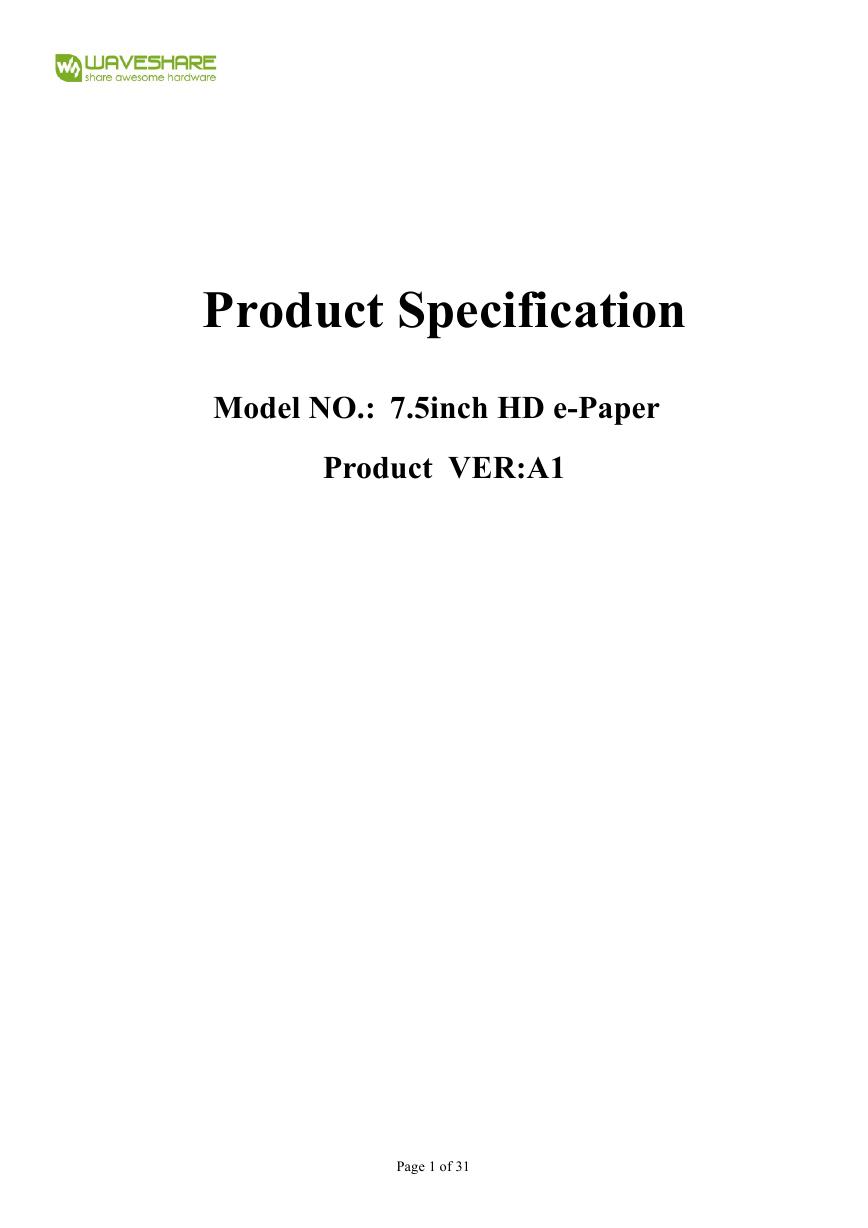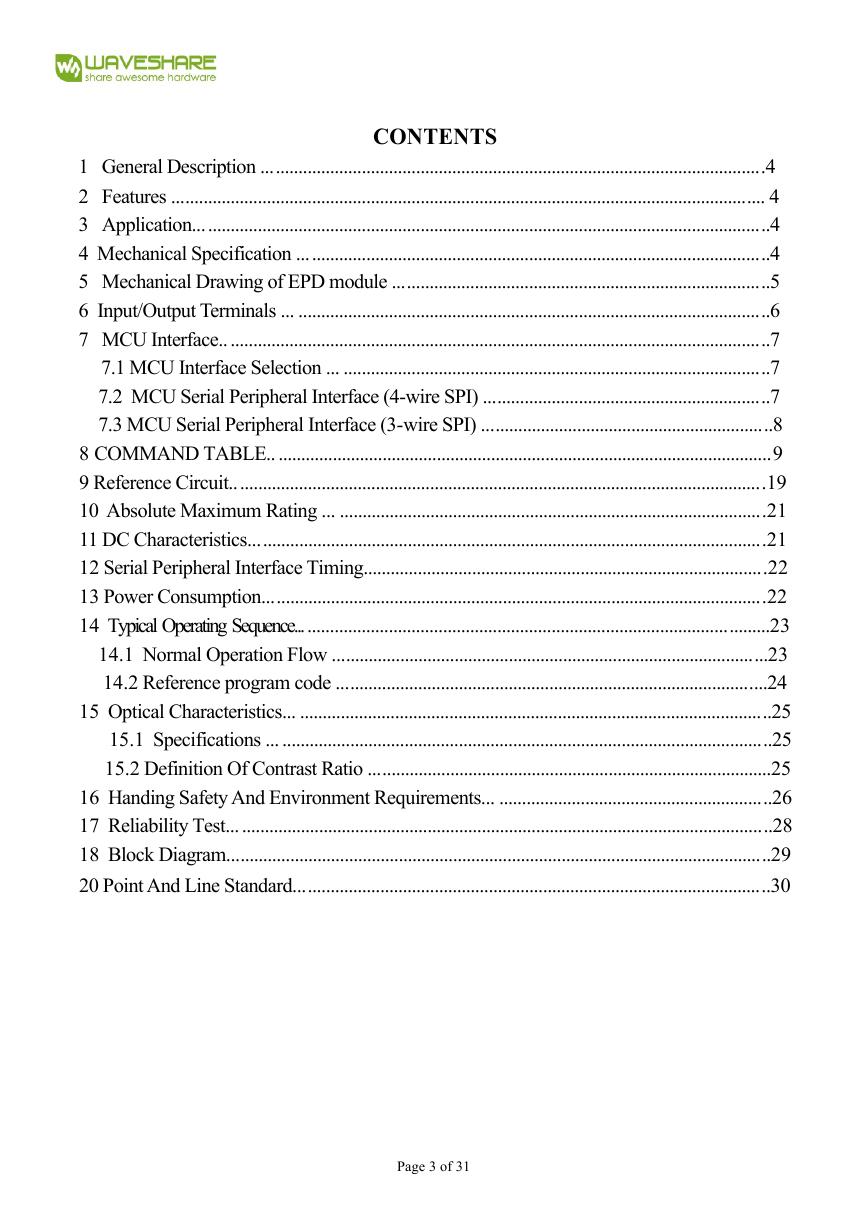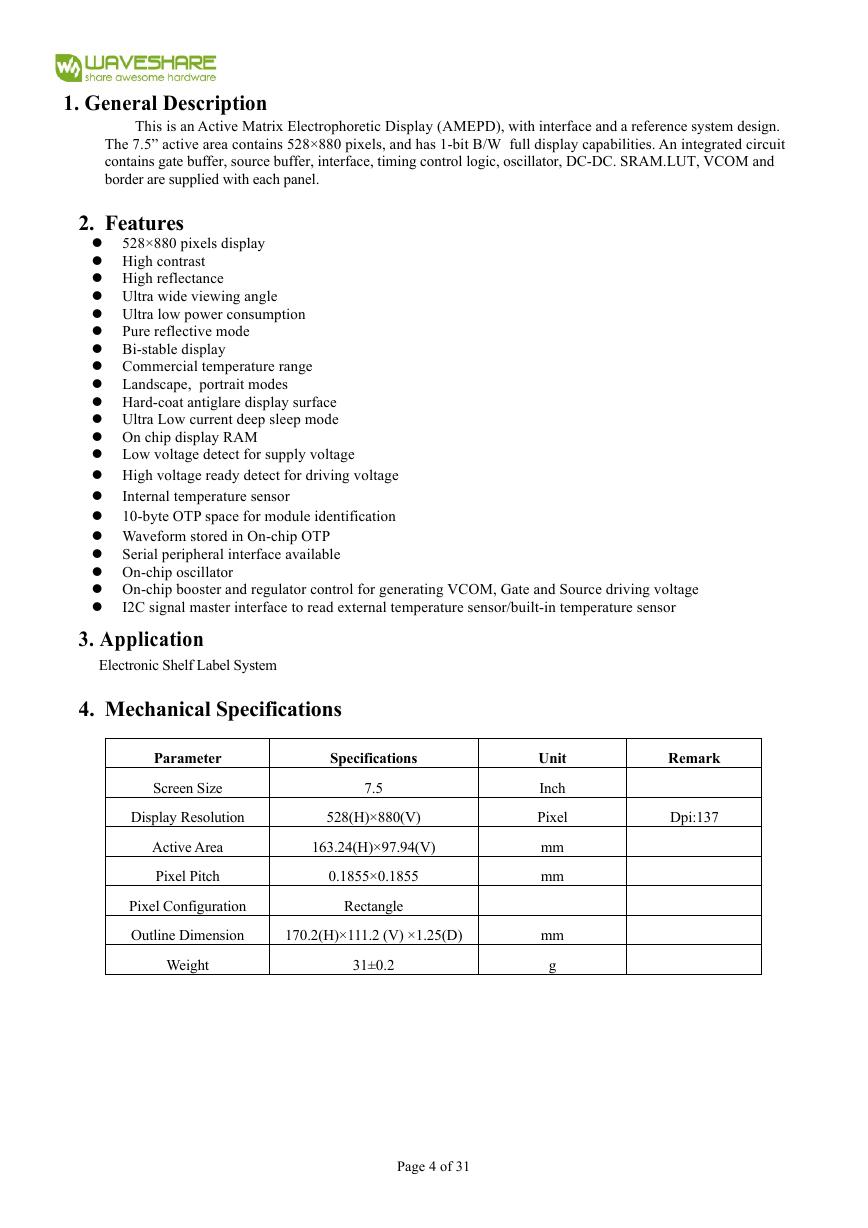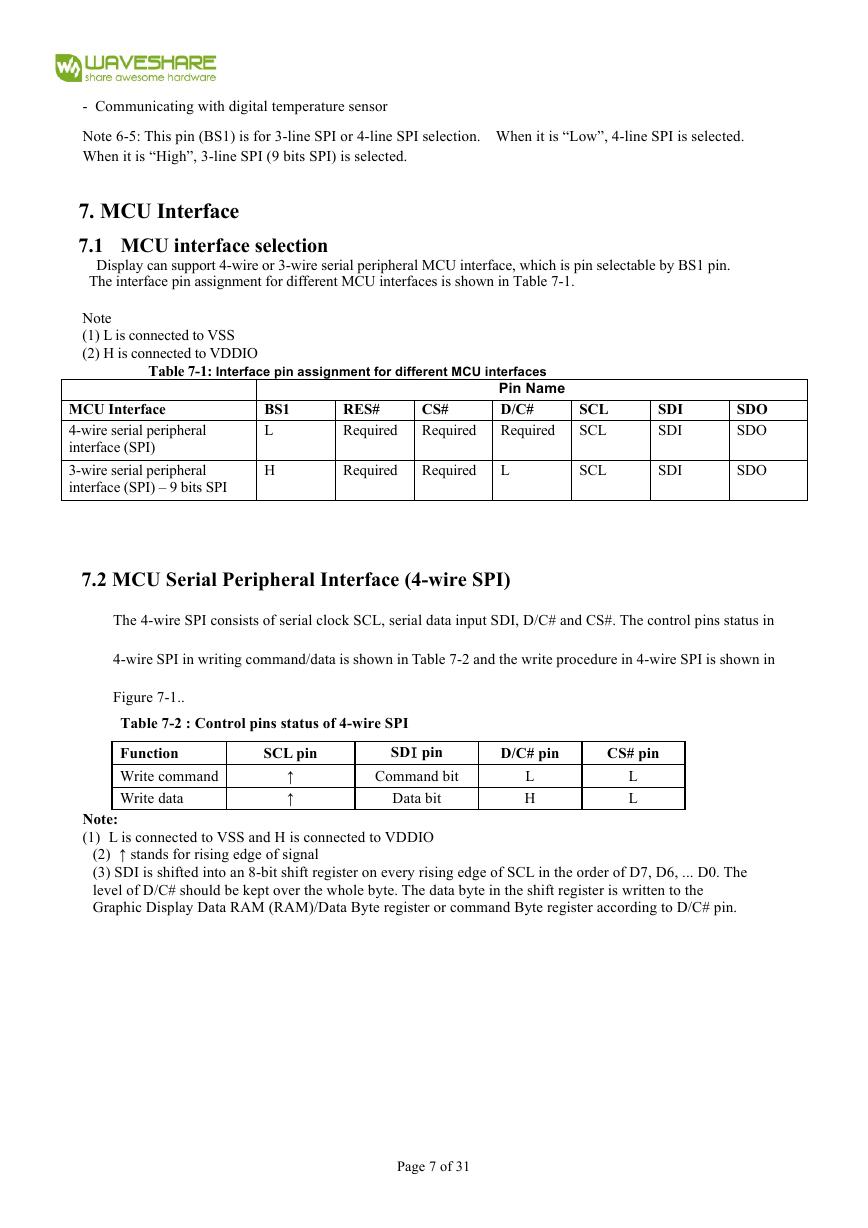Product Specification
Model NO.: 7.5inch HD e-Paper
Product VER:A1
Page 1 of 31
�
Version
A0
A1
Content
New release
Increasing the Brand of components
Date
Producer
Page 2 of 31
�
CONTENTS
1 General Description ... ........................................................................................................... .4
2 Features ... ............................................................................................................................ .... 4
3 Application... .......................................................................................................................... ..4
4 Mechanical Specification ... ................................................................................................... ..4
5 Mechanical Drawing of EPD module ... .............................................................................. ..5
6 Input/Output Terminals ... ...................................................................................................... ..6
7 MCU Interface.. ..................................................................................................................... ..7
7.1 MCU Interface Selection ... ............................................................................................ ..7
7.2 MCU Serial Peripheral Interface (4-wire SPI) ... .......................................................... ..7
7.3 MCU Serial Peripheral Interface (3-wire SPI) ... ........................................................... ..8
8 COMMAND TABLE.. ............................................................................................................. 9
9 Reference Circuit.. ................................................................................................................... .19
10 Absolute Maximum Rating ... ............................................................................................. .21
11 DC Characteristics... .............................................................................................................. .21
12 Serial Peripheral Interface Timing... ..................................................................................... .22
13 Power Consumption... ........................................................................................................... .22
14 Typical Operating Sequence... ............................................................................................. .........23
14.1 Normal Operation Flow ... .......................................................................................... ...23
14.2 Reference program code ... ........................................................................................ ....24
15 Optical Characteristics... ...................................................................................................... ..25
15.1 Specifications ... .......................................................................................................... ..25
15.2 Definition Of Contrast Ratio ... ......................................................................................25
16 Handing Safety And Environment Requirements... .......................................................... ..26
17 Reliability Test... ................................................................................................................... ..28
18 Block Diagram... ................................................................................................................... ..29
20 Point And Line Standard... .................................................................................................... ..30
Page 3 of 31
�
1. General Description
This is an Active Matrix Electrophoretic Display (AMEPD), with interface and a reference system design.
The 7.5” active area contains 528×880 pixels, and has 1-bit B/W full display capabilities. An integrated circuit
contains gate buffer, source buffer, interface, timing control logic, oscillator, DC-DC. SRAM.LUT, VCOM and
border are supplied with each panel.
2. Features
l 528×880 pixels display
l High contrast
l High reflectance
l Ultra wide viewing angle
l Ultra low power consumption
l Pure reflective mode
l Bi-stable display
l Commercial temperature range
l Landscape, portrait modes
l Hard-coat antiglare display surface
l Ultra Low current deep sleep mode
l On chip display RAM
l Low voltage detect for supply voltage
l High voltage ready detect for driving voltage
l
l 10-byte OTP space for module identification
l Waveform stored in On-chip OTP
l Serial peripheral interface available
l On-chip oscillator
l On-chip booster and regulator control for generating VCOM, Gate and Source driving voltage
l
3. Application
I2C signal master interface to read external temperature sensor/built-in temperature sensor
Internal temperature sensor
Electronic Shelf Label System
4. Mechanical Specifications
Parameter
Screen Size
Specifications
7.5
Display Resolution
528(H)×880(V)
Active Area
Pixel Pitch
Pixel Configuration
Outline Dimension
Weight
163.24(H)×97.94(V)
0.1855×0.1855
Rectangle
170.2(H)×111.2 (V) ×1.25(D)
31±0.2
Unit
Inch
Pixel
mm
mm
mm
g
Remark
Dpi:137
Page 4 of 31
�
5. Mechanical Drawing of EPD module
7
.
*
a
s
t
h
e
f
o
c
u
s
c
o
n
t
r
o
l
s
i
z
e
0
C
=
8
B
A
.
3
0
B
4
3
4
=
C
1
4
.
0
.
2
7
:
.
.
#
=
2
C
A
B
4
=
.
9
4
2
B
8
=
B5B3Y
B5B00Y
,
7
A
5
0
H
S
R
K
N
U
J
I
V
N
L
M
G
W
U
J
I
G
W
J
B
5
B
0
0
*
Y
A
*
,
*
Y
B
5
B
3
Y
,
,
B
S
W
G
P
Y
5
=
B
D
8
4
E
A
8
3
4
D
8
4
E
1
B
B
D
8
4
E
.
3
4
A
2
8
B
8
=
3
0
B
4
B
/
8
A
W
N
K
K
J
R
J
U
U
N
R
W
E
7
N
W
J
G
U
O
N
R
J
A
S
K
W
T
U
S
H
J
V
V
1
J
R
I
N
R
L
0
U
J
G
,
*
*,
D
2
D
6
D
A
D
6
7
D
A
7
D
D
3
3
D
A
A
D
2
8
D
3
3
8
A
3
0
A
2
2
A
3
#
2
4
A
1
C
A
F
B
A
3
0
B
A
2
D
A
7
1
A
=
2
6
3
4
A
4
=
2
8
=
A
8
6
=
0
Page 5 of 31
�
6. Input/Output Terminals
Pin #
1
2
3
4
5
6
7
8
9
10
11
12
13
14
15
16
17
18
19
20
21
22
23
24
Single
NC
GDR
RESE
NC
VSH2
TSCL
TSDA
BS1
BUSY
RES #
D/C #
CS #
SCL
SDA
VDDIO
VCI
VSS
VDD
VPP
VSH1
VGH
VSL
VGL
Description
Remark
No connection and do not connect with other NC pins
Keep Open
N-Channel MOSFET Gate Drive Control
Current Sense Input for the Control Loop
No connection and do not connect with other NC pins e
Keep Open
Positive Source driving voltage
I2C Interface to digital temperature sensor Clock pin
I2C Interface to digital temperature sensor Date pin
Note 6-5
Note 6-4
Note 6-3
Note 6-2
Note 6-1
Bus selection pin
Busy state output pin
Reset
Data /Command control pin
Chip Select input pin
serial clock pin (SPI)
serial data pin (SPI)
Power for interface logic pins
Power Supply pin for the chip
Ground
Core logic power pin
Power Supply for OTP Programming
Positive Source driving voltage
Power Supply pin for Positive Gate driving voltage and
VSH
Negative Source driving voltage
Power Supply pin for Negative Gate driving voltage,
VCOM and VSL
VCOM
VCOM driving voltage
Note 6-1: This pin (CS#) is the chip select input connecting to the MCU. The chip is enabled for MCU
communication:only when CS# is pulled LOW.
Note 6-2: This pin (D/C#) is Data/Command control pin connecting to the MCU. When the pin is pulled HIGH,
the data will be interpreted as data. When the pin is pulled LOW, the data will be interpreted as command.
Note 6-3: This pin (RES#) is reset signal input. The Reset is active low.
Note 6-4: This pin (BUSY) is Busy state output pin. When Busy is High the operation of chip should not be
interrupted and any commands should not be issued to the module. The driver IC will put Busy pin High when
the driver IC is working such as:
- Outputting display waveform; or
Page 6 of 31
�
- Communicating with digital temperature sensor
Note 6-5: This pin (BS1) is for 3-line SPI or 4-line SPI selection. When it is “Low”, 4-line SPI is selected.
When it is “High”, 3-line SPI (9 bits SPI) is selected.
7. MCU Interface
7.1 MCU interface selection
Display can support 4-wire or 3-wire serial peripheral MCU interface, which is pin selectable by BS1 pin.
The interface pin assignment for different MCU interfaces is shown in Table 7-1.
Table 7-1: Interface pin assignment for different MCU interfaces
Note
(1) L is connected to VSS
(2) H is connected to VDDIO
MCU Interface
4-wire serial peripheral
interface (SPI)
3-wire serial peripheral
interface (SPI) – 9 bits SPI
BS1
L
H
RES#
Required
CS#
Required
Pin Name
D/C#
Required
Required
Required
L
SCL
SCL
SCL
SDI
SDI
SDI
SDO
SDO
SDO
7.2 MCU Serial Peripheral Interface (4-wire SPI)
The 4-wire SPI consists of serial clock SCL, serial data input SDI, D/C# and CS#. The control pins status in
4-wire SPI in writing command/data is shown in Table 7-2 and the write procedure in 4-wire SPI is shown in
Figure 7-1..
Table 7-2 : Control pins status of 4-wire SPI
Function
Write command
Write data
SCL pin
↑
↑
SD pin
Command bit
Data bit
D/C# pin
CS# pin
L
H
L
L
Note:
(1) L is connected to VSS and H is connected to VDDIO
(2) ↑ stands for rising edge of signal
(3) SDI is shifted into an 8-bit shift register on every rising edge of SCL in the order of D7, D6, ... D0. The
level of D/C# should be kept over the whole byte. The data byte in the shift register is written to the
Graphic Display Data RAM (RAM)/Data Byte register or command Byte register according to D/C# pin.
Page 7 of 31
�
Figure 7- : Read procedure in 4-wire SPI mode
In the read operation, after CS# is pulled low, the first byte sent is command byte, D/C# is pulled low. After
command byte sent, the following byte(s) read are data byte(s), so D/C# bit is then pulled high. An 8-bit
data will be shifted out on every clock falling edge. The serial data output SDO bit shifting sequence is D7,
D6, to D0 bit. Figure 6-2 shows the read procedure in 4-wire SPI.
Figure 7-2: Read procedure in 4-wire SPI mode
7.3 MCU Serial Peripheral Interface (3-wire SPI)
The 3-wire SPI consists of serial clock SCL, serial data input SDI, and CS#. The operation is similar to 4-
wire SPI while D/C# pin is not used and it must be tied to LOW. The control pins status in 3-wire SPI is
shown in Table 7-3.
In the write operation, a 9-bit data will be shifted into the shift register on every clock rising edge. The bit
shifting sequence is D/C# bit, D7 bit, D6 bit to D0 bit. The first bit is D/C# bit which determines the
following byte is command or data. When D/C# bit is 0, the following byte is command. When D/C# bit is 1,
the following byte is data. Table 7-3 shows the write procedure in 3-wire SPI
Table 7-3 : Control pins status of 3-wire SPI
Function
SCL pin
SDI pin
D/C# pin
CS# pin
Page 8 of 31
�
















 V2版本原理图(Capacitive-Fingerprint-Reader-Schematic_V2).pdf
V2版本原理图(Capacitive-Fingerprint-Reader-Schematic_V2).pdf 摄像头工作原理.doc
摄像头工作原理.doc VL53L0X简要说明(En.FLVL53L00216).pdf
VL53L0X简要说明(En.FLVL53L00216).pdf 原理图(DVK720-Schematic).pdf
原理图(DVK720-Schematic).pdf 原理图(Pico-Clock-Green-Schdoc).pdf
原理图(Pico-Clock-Green-Schdoc).pdf 原理图(RS485-CAN-HAT-B-schematic).pdf
原理图(RS485-CAN-HAT-B-schematic).pdf File:SIM7500_SIM7600_SIM7800 Series_SSL_Application Note_V2.00.pdf
File:SIM7500_SIM7600_SIM7800 Series_SSL_Application Note_V2.00.pdf ADS1263(Ads1262).pdf
ADS1263(Ads1262).pdf 原理图(Open429Z-D-Schematic).pdf
原理图(Open429Z-D-Schematic).pdf 用户手册(Capacitive_Fingerprint_Reader_User_Manual_CN).pdf
用户手册(Capacitive_Fingerprint_Reader_User_Manual_CN).pdf CY7C68013A(英文版)(CY7C68013A).pdf
CY7C68013A(英文版)(CY7C68013A).pdf TechnicalReference_Dem.pdf
TechnicalReference_Dem.pdf